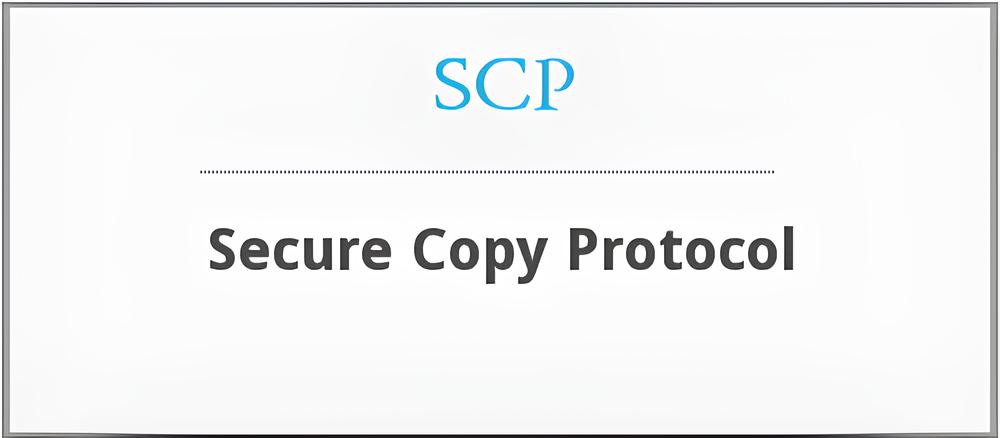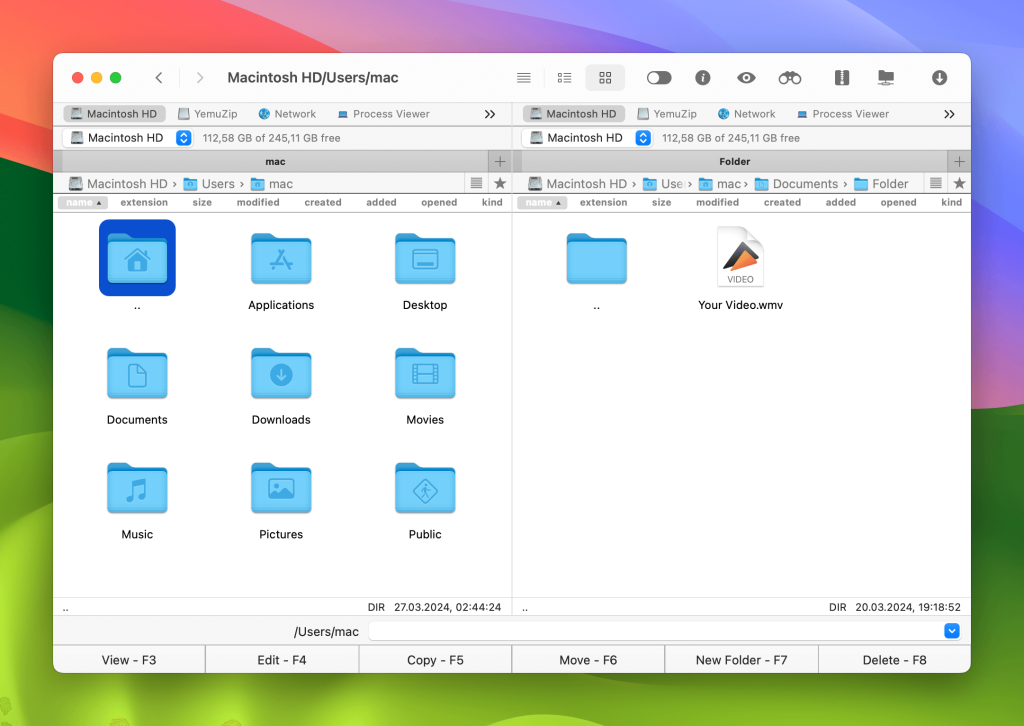Users who have recently switched to cloud hosting often have problems managing virtual server files, as many of them are not used to working with the command line. Fortunately, Commander One provides a user-friendly graphical interface with which you can upload new and move existing server files. Stop wondering whether to search for SCP client Mac solution or start using Commander One now.
What is an SCP protocol?

SCP (Secure Copy Protocol) is an application layer network protocol (and a similar utility) designed to transfer data between two network nodes (local and remote or a couple of remote ones). It works on top of the SSH protocol, using its mechanisms for authentication and data protection in transit that is why the SCP port number is also 22.
SCP is based on the RCP (Secure Copy) protocol/utility, which was part of the Berkeley r-commands (1982) software package, which has long been used on Unix OS and has become the de-facto standard for remote control on Unix. R-commands did not provide the required level of security (in particular, the data was not encrypted in transit) and were replaced by SSH shortly after its introduction.
How does SCP work? What is SCP command syntax?
This command is a special utility that can only work over the SSH (Secure Shell) protocol. The main requirement for transferring information from one PC to another is to run a special SSH server. The user must have a login and password from the server since without this information it will be impossible to launch it.
The command makes it possible to move documents of various sizes. This can be done not only between a local and a remote system but also between 2 remote servers. To carry out the event, you will need to know logins and passwords.
SCP command syntax
SCP [OPTIONS] [WHAT TO COPY] [WHERE TO COPY]
The SCP utility is highly functional. It is capable of accepting a large number of parameters as input, and also allows you to copy individual files and directories. They are specified in the “what to copy” section.
When performing the procedure, be sure to indicate where you want to transfer files and folders. The information is entered in the “where to copy” section.
The above two arguments can take different paths, both local and remote. It is possible to copy information from a remote personal computer to a stationary one, as well as to carry out the procedure exactly the opposite.
The “what to copy” and “where to copy” arguments have their own specific syntax:
(USER NAME) – (IP) – (PATH TO REQUIRED FILE OR DIRECTORY)
In this case, “username” is the login that is used when starting a special SSH server. The IP address of a personal computer or host. It is to or from them that files and directories will be copied.
SCP security: is it safe or not?
SCP provides a secure method for transferring files between hosts. In simple terms, SCP can be seen as an integration of RCP (Remote Copy Command in UNIX) and SSH. SCP encryption and authentication are provided using the SSH protocol, while BSD (Berkeley Software Distribution, sometimes called Berkeley Unix) RCP provides the basis for the actual file transfer. SCP operates on port 22. SCP prevents third parties from intercepting file transfers and viewing the contents of data packets.
When a client uploads a file to the server, it is given the option to enable properties such as timestamp, permissions, and so on. This capability is not provided in the widely used FTP (File Transfer Protocol) protocol. When a client needs to download a file/directory, it first sends a request to the server. Uploading is a server-driven process where files are transferred from the server to the client. This server-driven mechanism can pose a security risk, especially if the server is malicious.
What is the difference between FTP, SFTP, and SCP protocols?
There are not many differences between FTP and SFTP. The key difference is that SFTP uses a secure channel to transfer files while FTP doesn’t. That’s why FTP is the most insecure of all file transfer options, so you should never connect to a remote server using FTP. SCP and SFTP are just as easy to use but offer a much higher level of security. In addition, FTP requires the installation of an FTP server (such as vsFTP or ProFTP), while SFTP and SCP use SSH protocol and, as a result, when connected to a remote Unix-like server, they work automatically.
Both SFTP and SCP protocols provide a secure file transfer mechanism, there are some differences between them. SCP is a simple protocol that only allows files to be transferred, while SFTP provides a wide variety of operations for managing remote files.
In addition, when comparing an SFTP client to an SCP client Mac users agree that the SFTP client has additional capabilities such as deleting files remotely, resuming interrupted transfers, etc. Moreover, SFTP is more platform-independent than SCP. SFTP servers are available on several platforms, while SCP mainly uses Unix platforms.
When comparing speeds, SFTP is slower than SCP protocol as it requires waiting for encryption and acknowledgment of packets. SFTP provides support for files larger than 4GB, unfortunately, SCP transfers files of small size. SFTP provides the ability to cancel a file transfer without ending the session, whereas with SCP, the session must be canceled to cancel the transfer. In addition, transfer resumption is supported using SFTP, while SCP does not.
Secure Copy Protocol and File Transfer Protocol offer simple command-line methods for transferring files between computers, but the similarities end there. SCP is better designed for one-time transmission between two computers on the same network, although it can also be used remotely over the Internet. Conversely, FTP is used not only to transfer data to a remote server but also to manage that data.
Commander One - file manager that works with different protocols

Although the above protocols have similarities and differences, it would be unfair to say that one is better than the other. However, SCP protocol is not so commonly used among users as well as it is a bit difficult to find a decent Mac SCP client. As an alternative to this protocol, you can always use FTP or SFTP as they are widespread in use and there are a lot of FTP/SFTP clients for Mac on the market.
To be able to securely transfer files among remote servers and have them all listed as local drives on your computer, we recommend you to use Commander One. It is a handy file manager that would be a cup of tea for a lot of users. So, stop playing around with trying to find a decent SCP client for Mac as you can find everything you need in Commander One.
The app supports work with FTP, FTPS, SFTP, FTP with TLS/SSL, FTP with Implicit SSL, the most popular cloud storages, work with archives, ability to queue file operations, advanced search for files, ability to work with Android, iOS and MTP devices, built-in Terminal, Process viewer, etc.
Have the most convenient management over your files stored on the remote servers thanks to the dual-panel interface of the app and manage them as if they are stored on your local computer.
Conclusion
Secure Copy Protocol and Secure File Transfer Protocol are alternatives to File Transfer Protocol. All three can help move files over Ethernet, have things in common and things that differ from each of them. Finding a decent client that can help you facilitate transferring files would be a great plus in your workflow. So whether to use SCP client for Mac or alternative it’s up to you.
Frequently Asked Questions
SCP (Secure Copy) is based on the Secure Shell (SSH) protocol and enables secure file transfer between hosts.
There are several equivalents of WinSCP for Mac. They all differ in the range of offered features as well as price. We recommend you trying Commander One an excellent alternative to Mac SCP client.
In order to enable SCP SSH, go to System Preferences → Sharing → select the Remote Login checkbox. This will enable SSH and, in turn, SCP.
SCP runs over TCP port 22 by default. Like RCP, there is no RFC that defines the specifics of the protocol.
Each protocol has its own advantages and disadvantages. Depending on your needs you can choose the most suitable for you. However, FTP is not secure, that is why you cannot trust it with sensitive data, moreover, SFTP is more platform-independent than SCP. SFTP servers are available on several platforms, while SCP mainly uses Unix platforms.